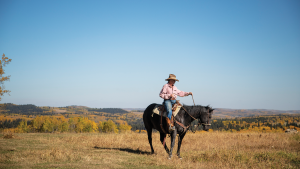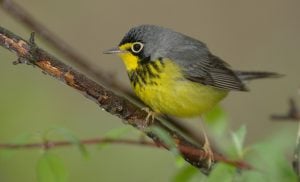Golden eagles are territorial and have home ranges that can cover as much as 200 square kilometres. They’re found throughout the northern hemisphere, and the majority of populations studied in Finland and Russia appear to be either year-round residents in their habitat or partial migrants, meaning only the juvenile birds travel far afield. The same was thought of the Alaska-Yukon population. Bird counts in the Rockies from the 1970s and early 80s noted anywhere from four to 50 birds per day in the spring and fall. When researchers recorded higher numbers, they assumed they were seeing migrating juveniles, or that inclement weather had concentrated the birds along the front ranges. No one suspected they were watching the largest golden eagle migration on the planet.
“When you see something that doesn’t fit with the known data, you assume it’s anomalous, but maybe it’s our knowledge that’s wrong,” Sherrington says.
Solving the migration mystery
In the fall of 1992, Sherrington began counting eagles in earnest, leaving his oil industry job to start the non-profit Rocky Mountain Eagle Research Foundation, also known as Eagle Watch. At Sherrington’s urging, volunteer eagle watchers fanned out to 16 sites spread over 500 kilometres along the front ranges in Banff and Jasper National Parks to try to confirm his suspicions that the birds were in fact migrating. The response from the birding community was overwhelming, he says.
“People just came. I don’t remember organizing them all. I must have done, but I think it’s just a case of when something is worth doing, people do it.”
When the results came in, “We had this stream of birds from Jasper all the way to Waterton,” Sherrington says. In the spring of 1993, they counted again, and tallied more than 4,000 birds, including 849 in a single day.
Their work continues: to date, thousands of volunteer scientists have logged more than 30,000 hours in the field, and recorded sightings of more than 24,000 golden eagles. They’ve been able to identify not only the migration route along the Rocky Mountain front, but also, working with data from researchers in Alaska and Montana, a secondary migration corridor further west through the Rocky Mountain trench.
“The eagles are using the ridges as long, elevated prairie roads,” explains Sherrington. Buoyant pockets of warm air, called thermals, sweep up the ridges, allowing the eagles to gain height while conserving precious energy.
During migration season, Sherrington works 17-hour days, compiling data, doing statistical analysis, and writing blogs, all of which he makes freely available on the Eagle Watch website for researchers and volunteers.
Declining numbers, increasing human threats
“Peter is a hero,” says Rob Domenech, founder of the Raptor View Research Institute in Montana. “His commitment to tracking raptor populations is invaluable.”
Since 2004, Domenech and the Raptor View team have been affixing numbered tags to the wings of wild eagles in order to make it easier for spotters to identify migrating individuals. Sightings of tagged eagles help fill in the blanks about where the eagles breed and winter, how far they travel, and threats they might encounter along their journey. To get even more precise data, they attach satellite telemetry units to some birds that report the eagle’s location every hour, 12 hours a day for however long the unit functions or the bird stays alive. Between Domenech’s team and other eagle research groups, more than 500 individual eagles have been telemetered to date. These data helped corroborate the migration corridors identified by Sherrington and the Eagle Watch volunteers.
Based on Eagle Watch’s 25 years worth of data, the current population of migrating golden eagles is now about 60 per cent of what it was in the early 90s. The eagles face a growing range of human-caused threats: they can be shot, electrocuted by power lines, killed by wind turbines, hit by cars as they’re feeding on roadkill, and caught in traps meant for other animals. Fifty-eight percent of the migrants that Domenech has caught and tagged tested positive for elevated levels of lead. The neurotoxin accumulates when they eat from gut piles left by hunters who’ve killed animals with lead bullets. The birds have lost habitat to agriculture, and their preferred prey species of prairie dogs and sage grouse are also at a fraction of their historic populations.
“[Golden eagles] are adaptable, intelligent, beautiful birds,” says Domenech, “but at what point do the scales get tipped and they won’t be able to adapt?”






